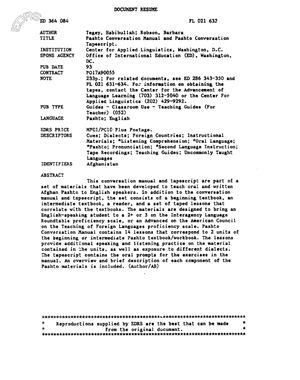Publisher: Office of Inteational Education
Date: 1993
Number of pages: 233
Govement-commissioned basic textbook of Conversational Pashto.
Beginning Pashto and intermediate Pashto constitute a set of m'lertals teaching oral and written Pashto. Each of the twenty-eight units (fourteen per book) provides about ten hours of class work, and therefore should be sufficient for four semesters of academic language training (three hours a week In class, with possibly two hours of lab or practice), or about ten weeks in an intensive course (six hours a day in class, five days a week). The materials are designed to bring an English-speaking student to a 2 or 3 on the ILR proficiency scale, or an Advanced on the ACTFL proficiency scale; all the grammatical structures of Pashto are presented, along with about 2,500 words.
The Pashto writing system is taught in the first unit of Beginning Pashto, and is used in the presentation of material from then on. In the first three units, material is also in a romanized transcription, After that, the transcription of a word or phrase is given only when the word or phrase Is introduced, or when pronunciation Is the focus.
Beginning and intermediate Pashto teach the language via dialogues and readings on various topics (e.g. food, shopping, weather, family, etc.). with accompanying presentations on grammar and vocabulary, and exercises for oral practice and conversation. Each unit contains a Diversion - a proverb, poem or story - intended to amuse the student, and to provide him or her with a glimpse of Pashto folk literature.
The dialogues revolve around the activities of a group of Pashtuns and Americans at an American university, so that the American student is provided with language and vocabulary of immediate usefulness. The readings for the most part describe Pashtun life and customs In Afghanistan, and are related to the topic in the corresponding dialogue. The dialogues and readings In Intermediate Pfls/rto continue along the same general format, but the focus of attention shifts to Afghanistan, and to more detailed study of Pashtun culture and Afghan history.
Date: 1993
Number of pages: 233
Govement-commissioned basic textbook of Conversational Pashto.
Beginning Pashto and intermediate Pashto constitute a set of m'lertals teaching oral and written Pashto. Each of the twenty-eight units (fourteen per book) provides about ten hours of class work, and therefore should be sufficient for four semesters of academic language training (three hours a week In class, with possibly two hours of lab or practice), or about ten weeks in an intensive course (six hours a day in class, five days a week). The materials are designed to bring an English-speaking student to a 2 or 3 on the ILR proficiency scale, or an Advanced on the ACTFL proficiency scale; all the grammatical structures of Pashto are presented, along with about 2,500 words.
The Pashto writing system is taught in the first unit of Beginning Pashto, and is used in the presentation of material from then on. In the first three units, material is also in a romanized transcription, After that, the transcription of a word or phrase is given only when the word or phrase Is introduced, or when pronunciation Is the focus.
Beginning and intermediate Pashto teach the language via dialogues and readings on various topics (e.g. food, shopping, weather, family, etc.). with accompanying presentations on grammar and vocabulary, and exercises for oral practice and conversation. Each unit contains a Diversion - a proverb, poem or story - intended to amuse the student, and to provide him or her with a glimpse of Pashto folk literature.
The dialogues revolve around the activities of a group of Pashtuns and Americans at an American university, so that the American student is provided with language and vocabulary of immediate usefulness. The readings for the most part describe Pashtun life and customs In Afghanistan, and are related to the topic in the corresponding dialogue. The dialogues and readings In Intermediate Pfls/rto continue along the same general format, but the focus of attention shifts to Afghanistan, and to more detailed study of Pashtun culture and Afghan history.

